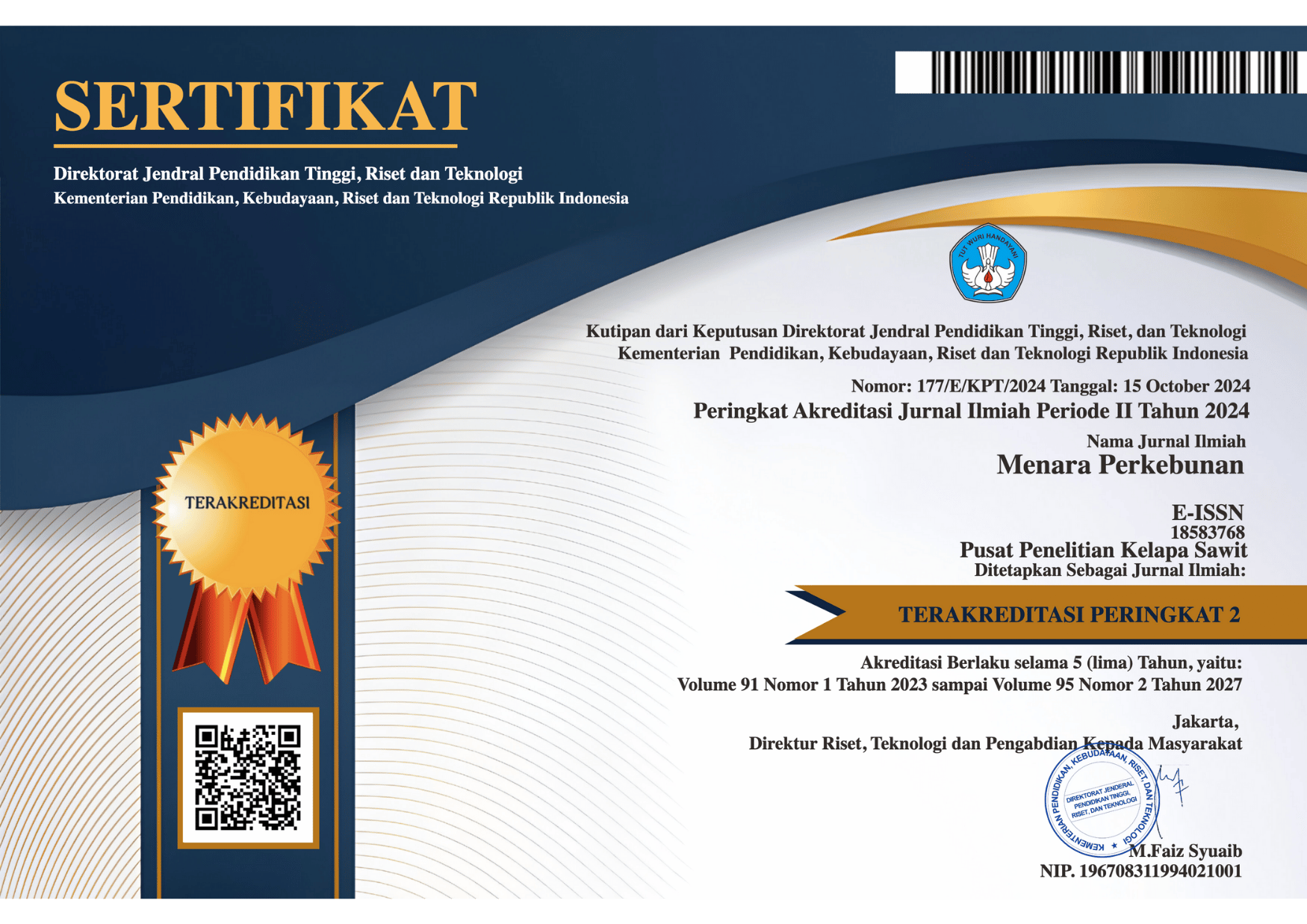Uji potensi Burkholderia cenocepacia strain KTG sebagai bahan aktif pembenah hayati pada tanah tekstur berpasir di Kalimantan Tengah The potential test of Burkholderia cenocepacia KTG strain as an active ingredient of bio-ameliorant in sandy-textured soil at Central Kalimantan
DOI:
https://doi.org/10.22302/iribb.jur.mp.v81i1.52Keywords:
Soil aggregate, root proliferation, endophytic bacteria, oil palm, bioaugmentationAbstract
Abstract
Oil palm plantation at Central Kalimantan has
been expanded to those areas with sandy-textured soil.
This type of soil has limiting factors for plant growth, i.e.
unstable soil aggregation and weak organic complex
bond that restrain root development and yield. However,
efforts to solve this problem are very limited. The
research aimed to develop technology to improve the
interactions for promoting a stable soil aggregate of
sandy-textured soil. The use of exopolysaccharide
producing bacteria as a soil bio-ameliorant to mediate
sandy soil micro aggregate formation by bio-augmenta-
tion technique has become an accepted practice. A highly
potential endophytic bacterium for exopolysaccharides
production was isolated from a sandy soil located at
Kotawaringin Barat-Central Kalimantan. The bacterium
was identified as Burkholderia cenocepacia KTG strain.
The field experiment has been organized according to the
method of randomized complete blocks design with seven
treatments of fertilizer in combination with bio-
ameliorant and replicated three times. Fertilizer and bio-
ameliorant application has been done in November 2009
- November 2011. Field trial was evaluated based on the
production of mature oil palm during January 2010-
December 2011 periods. The data obtained indicate that
application of bio-ameliorant combined with reduced
dosage of N-P-K 16-4-25 was not significantly different
to that of full dosage of N-P-K 16-4-25 treatment.
Abstrak
Pengembangan perkebunan kelapa sawit di
Kalimantan Tengah telah masuk ke wilayah dengan tanah
tekstur berpasir. Jenis tanah ini memiliki faktor pembatas
bagi pertumbuhan tanaman seperti ketidakstabilan agregat
tanah serta ikatan organik kompleks yang lemah,
sehingga perkembangan akar tanaman akan mengalami
hambatan dan pada akhirnya produktivitas menjadi sub
optimal. Bagaimanapun juga, upaya untuk memecahkan
masalah tersebut masih sangat terbatas. Penelitian ini
bertujuan mengembangkan teknologi untuk meningkat-
kan kemantapan agregat tanah tekstur berpasir. Pem-
bentukan mikro agregasi tanah dengan memanfaatkan
bakteri penghasil eksopolisakarida sebagai pembenah
hayati melalui teknik bioaugmentasi merupakan teknologi
yang dapat diterapkan secara praktis di lapang. Bakteri
endofitik penghasil eksopolisakarida potensial telah ber-
hasil diisolasi dari tanah tekstur berpasir, di daerah
Kotawaringin Barat, Kalimantan Tengah. Bakteri ini di-
identifikasi sebagai Burkholderia cenocepacia strain
KTG. Tujuh perlakuan yang diuji merupakan kombinasi
pupuk dan pembenah tanah hayati dengan tiga ulangan.
Aplikasi pupuk dan pembenah tanah hayati ini dilakukan
selama periode Nopember 2009 - Nopember 2011.
Evaluasi dilakukan atas dasar tingkat produktivitas
kelapa sawit yang sudah berproduksi selama 16 tahun
selama periode Januari 2010 - Desember 2011. Data yang
diperoleh menunjukkan bahwa dosis pembenah tanah
yang diuji yang dikom-binasikan dengan penurunan dosis
pupuk N-P-K 16-4-25 tidak berbeda nyata dengan
perlakuan penggunaan dosis penuh pupuk N-P-K 16-4-
25.
Downloads
Downloads
Submitted
Accepted
Published
How to Cite
Issue
Section
License
Copyright (c) 2016 Jurnal Menara Perkebunan

This work is licensed under a Creative Commons Attribution 4.0 International License.
Authors retain copyright and grant the journal right of first publication with the work simultaneously licensed under a Creative Commons Attribution License that allows others to share the work with an acknowledgement of the work's authorship and initial publication in this journal.













